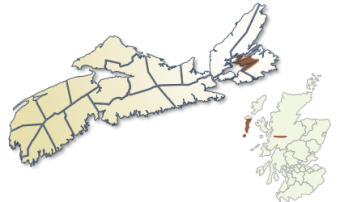![]()
An Drochaid Eadarainn Tha i seo 'na làraich-lìn a sholaraicheas dorust fosgailte do dhualchas beò na Gàidhlig mar a chìthear, a chluinnear 's a chleachdar a' là an-diugh ann an Gàidhealtachd na h-Albann Nuaidh.

Ged is e “Bras d’Or Lake” as tric a chìthear air na mapaichean, `s e Loch Mór nam Barrach a chanas cuid ris a' chuibhreann a `s motha dhi. Tha dualchas muinntir Bharraigh ri fhaighinn as gach ceàrn dhe `n roinn seo – cinnidhean mar Chloinn Nìll `s Cloinn ’Ill’Eathain. B’ ann à Barraidh, is na h-eileanan beaga `na cois, a thàinig iad tràth `s an naoidheamh linn deug. Gheobhar ann cuideachd sliochd Uibhist a Deas is Beinn na Faoghla, gu h-àraid mu thuath a null mu Bhaghasdail. `S e Caitligich a tha `s a’ mhór chuid. Chìthear mar theisteanas air an creideamh na h-eaglaisean brèagha air feadh na dùthcha mu `n cuairt. Tha Gàidheil nan crìochan seo air a bhith iomraiteach am measg luchd na Gàidhlig Cheap Breatuinn mar sheinneadairean, sgeulaichean is luchd-ciùil.
Neach-aithris: Séidheag Nic'illeMhaoil
Although you most often see Bras d’Or Lake written on maps, local Gaels often refer to “The Big Lake” as “The Great Lake of the Barra Men.” Large-scale settlement in the early 1800s from the Island of Barra and its outliers has left a great legacy of regional cultural and linguistic expression. North, on the Boisdale Peninsula, one will find the cultural contributions of descendants from settlers of South Uist and Benebecula stock. Most Gaels from this region traditionally adhere to the Catholic faith. Beautiful churches stand as a testament to the Church’s role in their communities. Gaels of central Cape Breton are well known as singers, storytellers, songmakers and musicians.
CAP-BRETON/GRAND LAC
Même si le nom qui figure le plus souvent sur les cartes est celui de « lac Bras d’Or », les Gaëls de la région l’appellent souvent le « Grand Lac » ou encore « le Grand Lac des hommes de Barra ». Il y a eu, au début du XIXe siècle, un grand établissement d’immigrants en provenance de l’île de Barra et ses enclaves nous ont légué un riche héritage culturel et linguistique pour la région. Au nord, dans la péninsule de Boisdale, on retrouve l’apport culturel des descendants d’immigrants de South Uist et de Benebecula. La plupart des Gaëls de cette région sont traditionnellement de confession catholique. La région compte de splendides lieux de culte, qui témoignent du rôle de l’Église dans ces communautés. Les Gaëls du centre du Cap-Breton sont bien connus en tant que chanteurs, conteurs, compositeurs et musiciens.
![]()
An Drochaid Eadarainn Tha i seo 'na làraich-lìn a sholaraicheas dorust fosgailte do dhualchas beò na Gàidhlig mar a chìthear, a chluinnear 's a chleachdar a' là an-diugh ann an Gàidhealtachd na h-Albann Nuaidh.